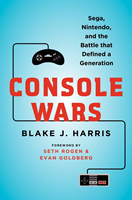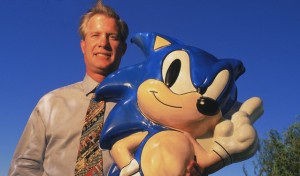 The news of the impending release of a book chronicling the fierce competition between Nintendo and Sega during the early ’90s was initially a bit surprising to me. I’ve long thought that the story was well worth telling (Sega-16 would never have existed otherwise), but given the incredibly pro-Nintendo revision gaming history has received over the past 20 years, it seemed unlikely to me that Sega would get a fair shake. When I learned that the book was to be set from mostly Sega’s perspective, that made me feel much better, but it set off a new round of fears.
The news of the impending release of a book chronicling the fierce competition between Nintendo and Sega during the early ’90s was initially a bit surprising to me. I’ve long thought that the story was well worth telling (Sega-16 would never have existed otherwise), but given the incredibly pro-Nintendo revision gaming history has received over the past 20 years, it seemed unlikely to me that Sega would get a fair shake. When I learned that the book was to be set from mostly Sega’s perspective, that made me feel much better, but it set off a new round of fears.
For years, there has been something of a schism between Sega fans regarding Sega of America and the policies and decisions made during the 16-bit era. Half believe that Tom Kalinske and his team did an excellent job at turning a company mostly known for its arcade wares into a console powerhouse. Others believe that those very same decisions are the reason for Sega’s defeats with the Saturn and Dreamcast and inevitably led to the company’s departure from the console hardware market.
Thus, the story could likely only go one of two ways: either the author would glorify Kalinske, hail him as Sega’s lone savior, and turn him into someone to be revered, or it would demonize him and lump the entirety of Sega’s ill fortunes upon his shoulders. Either one would be incorrect and its own species of revisionism, something Sega fans should not tolerate, regardless of the source. Thankfully, author Blake Harris has more respect for history than most of his predecessors and finds the soft spot right in the middle that’s likely as close to the truth as fans will ever get.
The first thing to keep in mind about Console Wars: Sega, Nintendo, and the Battle that Defined a Generation is that this is most definitely Sega’s story. Nintendo fans have benefitted from publications on that company’s history with texts like David Sheff’s Game Over and Osamu Inoue’s Nintendo Magic: Winning the Videogame Wars, but Segaphiles have never had a tome of their own. While Harris’ work isn’t exclusively about Sega and covers the entire breadth of the 16-bit generation, the perspective is almost entirely Sega’s. The story weaves back and forth between the upstart and its rival Nintendo to contrast the rising power of the one against the established dominance of the other in a way that allows readers to see both the immediate reactions and the long-term consequences of each powerhouse’s actions. By connecting it all from the viewpoint of Kalinske and his team, Harris provides a decidedly fresh take on events that many of us lived through but to whose underpinnings we weren’t privy.
Virtually all of Sega’s history from the 1990s is here, from Katz’s final conversation with Kalinske to the latter’s departure during the Saturn era. Readers see how Sonic was born and turned into the massive success he became in America, but most importantly, we see why he was so important to the U.S. Sega’s partnership with Sony is deeply fleshed out as well, along with Kalinske’s courting of Walmart and companies like Acclaim, the true impact of the Sega Summits, and how hard it was to win over the press. Harries makes an excellent guide through the chronological history of the most exciting time at one of the fastest-growing video game companies of the late 20th century, and it is always with a singular goal in mind: to illustrate the immense difficulty involved in taking on Nintendo. Many major parts of Sega’s history, such as the development and launches of the Sega CD and the Sega Channel, are glossed over or mentioned in passing, but that’s understandable, given the sheer amount of history to be covered and the narrative style of the book. The focus isn’t on every little thing Sega did during the period, but rather all the important things it did that made it such a success. Harris walks us through the timeline of Kalinske’s tenure, almost as if we were silently following the executive through his meetings with the ever-excited Al Nilsen, the crafty Olaf Olafsson, and numerous other industry personalities.
Great care is taken to tell the story from mostly Kalinske’s point of view, and indeed, one quickly senses that he is the main character. One may also get the impression that there is a certain degree of embellishment of his accomplishments at Mattel and Sega, given Kalinske’s reputation as the picture-perfect salesman, and the dialogue sometimes seems a bit too forced or rehearsed. However, there is more to the book than simply glorifying Kalinske’s optimism and business acumen. Behind every great leader there is a team, and Harris makes it a point to give every member of Sega, both American and Japanese, a turn in the spotlight. It then quickly becomes apparent that regardless the skill level of Sega of America’s CEO, it was the special combination of those around him that meshed together so well and gave Nintendo its first real competition. Without them, Kalinske would have had little success of which to speak. Sega’s success was, above all, a company-wide effort.
 Every facet of Sega’s management is given its due, from the team behind its greatest achievement (rightfully pulling the attention away from solely Yuji Naka) to those at Sega Europe and Sega Japan that worked so tirelessly to put the Genesis on the map. Most notable is the fact that Console Wars paints Sega Enterprises head Hayao Nakayama in a very human light, noting his strong support and deep friendship with Kalinske. Harris does this with most of the major players involved, from personal accounts involving Kalinske’s own children to Nilsen’s shattering the stereotypical perceptions of SOJ executives over a plate of puffer fish. There are people, not merely characters in a story, and an attachment to them develops over the course of the book. We want them to succeed, to overtake Nintendo, not out of bias or console preference, but because we see just how hard they work to do so. Every marketing strategy they create, every partnership they strive to forge, every failure with retailers and upper management – they are all targets for our empathy.
Every facet of Sega’s management is given its due, from the team behind its greatest achievement (rightfully pulling the attention away from solely Yuji Naka) to those at Sega Europe and Sega Japan that worked so tirelessly to put the Genesis on the map. Most notable is the fact that Console Wars paints Sega Enterprises head Hayao Nakayama in a very human light, noting his strong support and deep friendship with Kalinske. Harris does this with most of the major players involved, from personal accounts involving Kalinske’s own children to Nilsen’s shattering the stereotypical perceptions of SOJ executives over a plate of puffer fish. There are people, not merely characters in a story, and an attachment to them develops over the course of the book. We want them to succeed, to overtake Nintendo, not out of bias or console preference, but because we see just how hard they work to do so. Every marketing strategy they create, every partnership they strive to forge, every failure with retailers and upper management – they are all targets for our empathy.
Through it all, we see the fragile relationship between Sega’s eastern and western halves, and the evidence of its unraveling slowly rises to the surface over the course of the 552-page chronicle. While gamers have long speculated as to how strained things were between the two sides, Harris carefully details the reasons for the breakdown, with insight from personnel from both Sega of America and (finally) Sega of Japan. Nakayama’s surprising role as peacekeeper (one he played often) is revealed, and the frustrations on both sides are soundly clarified.
As entertainment, Console Wars makes for fascinating reading, and Harris’ writing style works well for developing the narrative. There is some clunky dialogue, but the majority is engaging enough. Where this take on events falls short is from a historical perspective. Since the book speaks mostly from Kalinske’s perspective, there is an underlying feeling that most of the information could have come from only a few people, as opposed to the 200+ that Harris reportedly interviewed. Moreover, the narrative style makes it impossible to know exactly who said what, and since much of the dialogue is an educated guess written by Harris himself, nothing is quotable. This problem makes the book’s historical value questionable.
Despite these shortcomings, Console Wars is a book that no Sega fan should miss. It can be argued that this is because there is little competition for it, and that may well be true, but to so narrowly categorize it would downplay its potential historical importance. The level of research here is impressive, and the information presented provides multiple jump-on points for an immense number of future publications. Questions will certainly arise, doubts will definitely be cast, but there is still much to be learned about the circumstances behind many of the notable business moves Sega made with its most successful console.
While this is certainly the first profound look behind the Sega curtain, it is also a great compliment to the Nintendo literature already available. Mario fans would do well to view the era through the hedgehog’s lens in order to gain a more complete perspective of exactly what happened. No matter which company one favors, the story behind their rivalry is captivating and unique, and gamers owe it to themselves to learn more regarding their history. A great deal of the gaming industry looks as it does today precisely because of what Console Wars reveals. Sega fans, Nintendo fans, and anyone who simply enjoys picking up a controller and playing should read and learn about the most exciting time in the history of video games. Every industry has its leaders, but it’s the upstarts who make things interesting. The ’90s saw perhaps gaming’s biggest battle between the two, and now we finally have a chance to see both sides of how it happened.

The movie is already in the works as well. I’m so glad I got to witness the REAL console wars Lol. Unlike now, back then most kids that I knew had either a SNES or gen as buying two consoles wasn’t gonna fly w/ most parents. That meant the system u had wasn’t just a an financial investment for parents.. It was a social and emotional one for us kids. The “debates” about why one system was better didn’t take place on the non existent interwebs.. They took place @ school..or houses, wen you showed your friend with the opposite console how your version of Mk had blood and fatalities, or they showed you they have final fight, then u counter with streets of rage and so on..good times
It should be available on Amazon.
Awesome! Where could I get this bad boy??